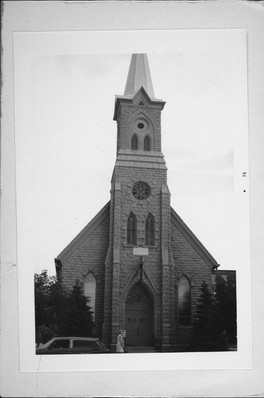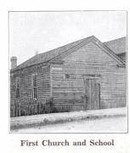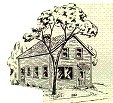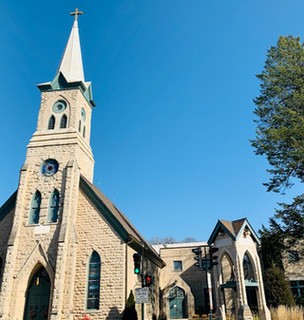Immanuel Evangelical Lutheran Church
Introduction
Text-to-speech Audio
This church is also another iconic one next to Saint Francis Borgia Catholic Church. Earlier in the tour, we talked about the huge influence of the German-Lutheran community here in town. That theme is continuing here with Immanuel Evangelical Lutheran Church. Not only its design very historic, but its origins go back to 1852.
Images
The Church In The 1960s.

This Was The First Church And School As Well.

A Sketch Showing The First Church And School

The Church Today.

Backstory and Context
Text-to-speech Audio
Reverand, E.G., Strassburger helped build this church and established it in 1882. Constructed mainly by the Reverand and the German Lutheran congregation that was established there. The establishment of this church goes back to 1852; Washington Avenue, as described before, was a dirt and mud road that took up the space of the entire downtown section of Cedarburg. The church itself and its congregation was originally part of the Lutheran Church-Missouri Synod. But later in the early twentieth-century, there was a difference in belief between traditional Lutheranism and a new denomination called Evangelical Lutheranism. In 1919, the origins of this new belief would impact the church here. They would become a part of the American Lutheran Church (ALC) which in the late 1980s would change itself to The Evangelical Lutheran Church Of America (ELCA).
Once these quarters became too cramped, its first congregation would meet in a small building south of the church. The congregation decided to build their Gothic-inspired church design with roughed quarry stone sides with a rock-faced limestone facade. Once Reverand Strassburger and the rest of the congregation finished building the church in 1882, the cost to build it was only around $7,745 to build the stone church. Even before the church was established, like many German immigrants in Cedarburg and the rest of Ozaukee County, most sermons and worship services were spoken in German. The Nieman family was the most notable of the congregation to attend worship and other church services. Reverand Strassburger would be the church's pastor for 46 years and spoke German. But in 1901, the demand for services now to be conducted in English was sweeping the area; the Reverand decided to accommodate those needs and, in 1904, helped establish an English-speaking church in Cedarburg and his own.
The additions to the building show the height of German architecture. The stone on the building came from the Anschuetz quarry in Cedarburg itself. In addition, a channel was added to the southern portion of the church. The tower that makes the church just as unique as Saint Francis Borgia is a buttressed tower that used to hold two bells; there, the giant bell weighed 3,054 pounds when it was added in 1891, but then it was removed and re-established and is now a street-level bell. This addition would be made in 2004, mainly due to the commemoration of the congregation and church's founding going back to 1852. The tower was also used to house a hand-wound clock that helped tell the time. But this clock did not use the original mechanism to help turn the clock tables; it mainly consisted of a wooden mechanism still on display in the church. Finally, the art glass windows of the structure were installed at the turn of the twentieth or twenty-first century, showing intense colors and religious symbolism, making this church another unique one here in Cedarburg.
Sources
Krueger, Franklin. Our History, Immanuel Lutheran: Cedarburg. 2002. Accessed May 21st 2022. https://www.immanuelcedarburg.org/our-history.
A Walk Through Yesterday: In Cedarburg Wisconsin. 2005.
Zimmermann, H. Russell. The Heritage Guidebook: Landmarks And Historic Sites In Southeastern Wisconsin. Milwaukee, Wisconsin. Heritage Banks, 1976. 192.
Zimmermann, H. Russell. The Heritage Guidebook: Landmarks And Historic Sites In Southeastern Wisconsin Highlights Of Historic Cedarburg. Milwaukee, Wisconsin. Heritage Banks, 1976.
Cedarburg History: Legend And Lore. Edition 1st. Cedarburg, Wisconsin. Library Of Congress, 1976.
Hansen, Harold E.. Sketches Of Cedarburg: Celebrating 100 Years. Cedarburg, Wisconsin. Cedarburg Commemorative Corporation, 1985. 93.
First Immanuel Lutheran Church, Ozaukee County: Wisconsin. Accessed May 21st 2022. https://www.co.ozaukee.wi.us/732/First-Immanuel-Lutheran-Church.
https://www.wisconsinhistory.org/Records/Property/HI13345
https://www.co.ozaukee.wi.us/732/First-Immanuel-Lutheran-Church
https://www.co.ozaukee.wi.us/732/First-Immanuel-Lutheran-Church
https://www.immanuelcedarburg.org/
